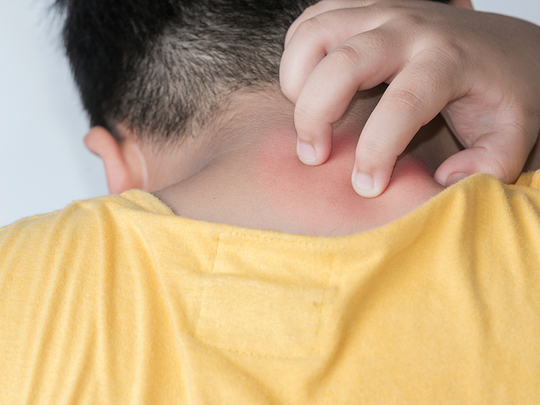
A reader asks: My 10-year-old son suffers from itchiness and rashes on the skin for the last six years. He has also developed oozing and crusting on the scalp and face. We tried modern medications on and off, with no significant changes. Is there any solution in Ayurveda ?
Dr Jomol Mariam Thomas, Senior Ayurveda Consultant, Dr Shyam’s Ayurveda Centre, Dubai, replies: The symptoms elicit the probable diagnosis of Atopic Dermatitis or eczema, which is also known as infantile eczema . Considering the lesions on the scalp and face, the possibility of Seborrhoeic dermatitis cannot be ruled out .
Dermatitis is a condition of skin inflammation with the primary symptoms of dry and scaly skin. It most often appears on the arms and legs. Other common sites are the scalp, face, knees and feet. The scaly skin of the affected areas can appear red and turn brown. It can also ooze and crust. Anyone from an infant to an elderly person can have eczema, but the one that is commonly seen in childhood is atopic dermatitis.
The occurrence is influenced by multiple factors like genetic predisposition, environmental or food allergens, contact irritants etc . It is estimated that 3/4th of the cases of atopic dermatitis improve as they reach adulthood.
Ayurveda considers it as Vicharchika, a skin condition in which Kapha dosha is predominant. According to Ayurveda, imbalance of any of the thridoshas (vatha, Pitha or Kapha – the fundamental energy factors that support life) cause diseases. The imbalanced Kapha dosha weakens the body immune system and increases the risk of Kaphajanya rogas . Considering the predominance of Kapha dosha during childhood, children are prone to the diseases with Kapha dominance like asthma, allergic rhinitis , bronchitis ,allergic eczema etc, also because they indulge in too much of Kapha increasing foods like sweets, milk and milk products.
The imbalanced Kapha dosha when gets localized in skin, produces blisters , severe itching , oozing and sometimes blackish discoloration and dryness of skin , if vatha is involved .
The primary Ayurvedic approach of treatment would be balancing the imbalanced doshas by the
- Avoidance of causative or trigger factors
- The oral medicines that pacify the aggravated doshas
- Medicines for regular detoxification
- Diet and life style modification
Identification of dosha involved and avoidance of the trigger factors play an important role in the treatment.
- Avoid the contact with irritants or allergens like soaps, detergents, furry things, woolen products, dust, smoke etc.
- Any indulgence in which there is sudden change of body temperature can also cause the imbalance of doshas, like exposure to air conditioning soon after a hot water bath as well as bathing with or drinking cold water soon after the exposure to hot sun etc .
- Diet always plays an important role in Ayurvedic treatment. Pathya ahara (the whole some diet) leads to well being where as the Apathya ahara (unwholesome diet) shows the way to ill health. Avoid foods that increase phlegm (kapha balancing diet can be followed ). Salt must be reduced in the diet, so as canned foods with added preservatives, flavour and colour .
- Sour foods must be avoided while you can favour bitter tastes. Avoid milk , cheese, yoghurt , meat, poultry and sea foods (body immune system reacts to the protein in it and can trigger an outbreak)
- Regular intake of water processed with Khadira-Acacia catechu (karingali in Malayalam ) is found beneficial for long term control.
- Turmeric powder ½ spoon added to 50ml fresh squeezed coconut milk may be taken in case of itching . Turmeric can be used liberally in flavoring the food.
- Local wash of lesions with thriphala water or neem water may be helpful in cleansing the lesions and to speed up the healing .
- Regular usage of thriphala as a laxative and application of Eladikeram or Nalpamaradi oils can also be tried.
Disclaimer: This blog is a conversation and is not an alternative for treatment. The recommendations and suggestions offered by our panel of doctors are their own and Gulf News will not take any responsibility for the advice they provide.








